Associations and Within-Group Differences in Physical Characteristics and Golf Performance Data in High-Level Amateur Players
Abstract
1. Introduction
2. Methods
2.1. Experimental Design
2.2. Subjects
2.3. Procedures
2.3.1. Equipment Set-Up
2.3.2. Seated Thoracic Rotation
2.3.3. Countermovement Jump
2.3.4. Seated Medicine Ball Throw
2.3.5. Isometric Bench Press
2.3.6. Isometric Mid-Thigh Pull
2.4. Statistical Analysis
3. Results
4. Discussion
4.1. Anthropometry
4.2. Isometric Strength: Upper and Lower Body
4.3. Explosive Strength: Upper and Lower Body
4.4. Mobility
4.5. Median Split Analysis
4.6. Limitations
5. Conclusions
Author Contributions
Funding
Institutional Review Board Statement
Informed Consent Statement
Data Availability Statement
Conflicts of Interest
References
- Broadie, M. Assessing golfer performance on the PGA TOUR. Interfaces 2012, 42, 146–165. [Google Scholar] [CrossRef]
- Broadie, M. Every Shot Counts: Using the Revolutionary Strokes Gained Approach to Improve Your Golf Performance and Strategy; Avery: Brea, CA, USA, 2014. [Google Scholar]
- Brennan, A.; Ehlert, A.; Wells, J.; Broadie, M.; Coughlan, D.; Turner, A.; Bishop, C. Monitoring performance in golf: More than just clubhead speed. Strength Cond. J. 2022, 45, 631–641. [Google Scholar] [CrossRef]
- Wells, J.E.; Mitchell, A.C.; Charalambous, L.H.; Fletcher, I.M. Relationships between highly skilled golfers’ clubhead velocity and kinetic variables during a countermovement jump. Sports Biomech. 2022, 1–13. [Google Scholar] [CrossRef] [PubMed]
- Coughlan, D.; Taylor, M.J.; Jackson, J.; Ward, N.; Beardsley, C. Physical characteristics of youth elite golfers and their relationship with driver clubhead speed. J. Strength Cond. Res. 2020, 34, 212–217. [Google Scholar] [CrossRef] [PubMed]
- Read, P.J.; Lloyd, R.S.; Croix, M.D.; Oliver, J.L. Relationships between field-based measures of strength and power and golf club head speed. J. Strength Cond. Res. 2013, 27, 2708–2713. [Google Scholar] [CrossRef] [PubMed]
- Gordon, B.S.; Moir, G.L.; Davis, S.E.; Witmer, C.A.; Cummings, D.M. An investigation into the relationship of flexibility, power, and strength to club head speed in male golfers. J. Strength Cond. Res. 2009, 23, 1606–1610. [Google Scholar] [CrossRef] [PubMed]
- Bishop, C.; Brennan, A.; Ehlert, A.; Wells, J.; Brearley, S.; Coughlan, D. S&C for golf athletes: Biomechanics, common injuries, and physical requirements. Prof. Strength Cond. J. 2022, 63, 7–18. [Google Scholar]
- Read, P.J.; Lloyd, R.S. Strength and conditioning considerations for golf. Strength Cond. J. 2014, 36, 24–33. [Google Scholar] [CrossRef]
- Hellström, J. The relation between physical tests, measures, and clubhead speed in elite golfers. Int. J. Sports Sci. Coach. 2008, 3, 85–92. [Google Scholar] [CrossRef]
- Wells, J.E.; Mitchell, A.C.; Charalambous, L.H.; Fletcher, I.M. Relationships between highly skilled golfers’ clubhead velocity and force producing capabilities during vertical jumps and an isometric mid-thigh pull. J. Sports Sci. 2018, 36, 1847–1851. [Google Scholar] [CrossRef]
- Keogh, J.W.; Marnewick, M.C.; Maulder, P.S.; Nortje, J.P.; Hume, P.A.; Bradshaw, E.J. Are anthropometric, flexibility, muscular strength, and endurance variables related to clubhead velocity in low-and high-handicap golfers? J. Strength Cond. Res. 2009, 23, 1841–1850. [Google Scholar] [CrossRef]
- Sheehan, W.B.; Watsford, M.L.; Pickering Rodriguez, E.C. Examination of the neuromechanical factors contributing to golf swing performance. J. Sports Sci. 2019, 37, 458–466. [Google Scholar] [CrossRef]
- Sorbie, G.G.; Glen, J.; Richardson, A.K. Positive relationships between golf performance variables and upper body power capabilities. J. Strength Cond. Res. 2021, 35, 97–102. [Google Scholar] [CrossRef]
- Wells, J.E.; Langdown, B.L. Sports science for golf: A survey of high-skilled golfers’ “perceptions” and “practices”. J. Sports Sci. 2020, 38, 918–927. [Google Scholar] [CrossRef]
- Cheetham, P.J.; Martin, P.E.; Mottram, R.E.; St Laurent, B.F. The importance of stretching the “X-Factor” in the downswing of golf: The “X-Factor Stretch”. Optimising Perform. Golf 2001, 192–199. [Google Scholar]
- Brown, S.J.; Nevill, A.M.; Monk, S.A.; Otto, S.R.; Selbie, W.S.; Wallace, E.S. Determination of the swing technique characteristics and performance outcome relationship in golf driving for low handicap female golfers. J. Sports Sci. 2011, 29, 1483–1491. [Google Scholar] [CrossRef]
- Brennan, A.; Murray, A.; Coughlan, D.; Mountjoy, M.; Wells, J.; Ehlert, A.; Xu, J.; Broadie, M.; Turner, A.; Bishop, C. Validity and Reliability of the FlightScope Mevo+ Launch Monitor for Assessing Golf Performance. J. Strength Cond. Res. 2023, 10–519. [Google Scholar] [CrossRef]
- FlightScope Mevo+ Edition. FlightScope Mevo UK Store. 2023. Available online: https://flightscopemevo.co.uk/products/flightscope-mevo-plus-2023 (accessed on 18 June 2023).
- Pro V1x Radar Capture Technology (RCT)|Titleist. 2023. Available online: https://www.titleist.co.uk/en_GB/product/pro-v1x-rct/004PVXRCT.html (accessed on 18 June 2023).
- Furness, J.; Schram, B.; Cox, A.J.; Anderson, S.L.; Keogh, J. Reliability and concurrent validity of the iPhone® Compass application to measure thoracic rotation range of motion (ROM) in healthy participants. Peer J. 2018, 6, 4431. [Google Scholar] [CrossRef]
- Dynamics, H. User Manual. Available online: https://www.hawkindynamics.com/manual-getting-started (accessed on 20 November 2023).
- Berberet, D. Countermovement Jump Metrics 2019. Available online: https://www.hawkindynamics.com/blog/countermovement-jump-metrics-2019 (accessed on 20 November 2023).
- Haff, G.G.; Ruben, R.P.; Lider, J.; Twine, C.; Cormie, P. A comparison of methods for determining the rate of force development during isometric midthigh clean pulls. J. Strength Cond. Res. 2015, 29, 386–395. [Google Scholar] [CrossRef]
- Comfort, P.; Dos’ Santos, T.; Beckham, G.K.; Stone, M.H.; Guppy, S.N.; Haff, G.G. Standardization and methodological considerations for the isometric midthigh pull. Strength Cond. J. 2019, 41, 57–79. [Google Scholar] [CrossRef]
- Beckham, G.K.; Lamont, H.S.; Sato, K.; Ramsey, M.W.; Stone, M.H. Isometric strength of powerlifters in key positions of the conventional deadlift. J. Trainology 2012, 1, 32–35. [Google Scholar] [CrossRef]
- Beckham, G.K.; Sato, K.; Santana, H.A.; Mizuguchi, S.; Haff, G.G.; Stone, M.H. Effect of body position on force production during the isometric midthigh pull. J. Strength Cond. Res. 2018, 32, 48–56. [Google Scholar] [CrossRef]
- Owen, N.J.; Watkins, J.; Kilduff, L.P.; Bevan, H.R.; Bennett, M.A. Development of a criterion method to determine peak mechanical power output in a countermovement jump. J. Strength Cond. Res. 2014, 28, 1552–1558. [Google Scholar] [CrossRef]
- Koo, T.K.; Li, M.Y. A guideline of selecting and reporting intraclass correlation coefficients for reliability research. J. Chiropr. Med. 2016, 15, 155–163. [Google Scholar] [CrossRef]
- Cormack, S.J.; Newton, R.U.; McGuigan, M.R.; Doyle, T.L. Reliability of measures obtained during single and repeated countermovement jumps. Int. J. Sports Physiol. Perform. 2008, 3, 131–144. [Google Scholar] [CrossRef]
- Hopkins, W.; Marshall, S.; Batterham, A.; Hanin, J. Progressive statistics for studies in sports medicine and exercise science. Med. Sci. Sports Exerc. 2009, 41, 3. [Google Scholar] [CrossRef]
- Rhea, M.R. Determining the magnitude of treatment effects in strength training research through the use of the effect size. J. Strength Cond. Res. 2004, 18, 918–920. [Google Scholar]
- MacKenzie, S.; McCourt, M.; Champoux, L. How Amateur Golfers Deliver Energy to the Driver. Int. J. Golf Sci. 2020, 8, 1–21. [Google Scholar]
- Wells, G.D.; Elmi, M.; Thomas, S. Physiological correlates of golf performance. J. Strength Cond. Res. 2009, 23, 741–750. [Google Scholar] [CrossRef]
- Meister, D.W.; Ladd, A.L.; Butler, E.E.; Zhao, B.; Rogers, A.P.; Ray, C.J.; Rose, J. Rotational biomechanics of the elite golf swing: Benchmarks for amateurs. J. Appl. Biomech. 2011, 27, 242–251. [Google Scholar] [CrossRef]
- Häkkinen, K. Force production characteristics of leg extensor, trunk flexor and extensor muscles in male and female basketball players. J. Sports Med. Phys. Fit. 1991, 31, 325–331. [Google Scholar]
- Marshall, K.J.; Llewellyn, T.L. Effects of flexibility and balance on driving distance and club head speed in collegiate golfers. Int. J. Exerc. Sci. 2017, 10, 954–963. [Google Scholar]
- Loock, H.; Grace, J.; Semple, S. Association of selected physical fitness parameters with club head speed and carry distance in recreational golf players. Int. J. Sports Sci. Coach. 2013, 8, 769–777. [Google Scholar] [CrossRef]
- Ehlert, A. The correlations between physical attributes and golf clubhead speed: A systematic review with quantitative analyses. Eur. J. Sport Sci. 2021, 21, 1351–1363. [Google Scholar] [CrossRef]
- Kotsifaki, A.; Korakakis, V.; Whiteley, R.; Van Rossom, S.; Jonkers, I. Measuring only hop distance during single leg hop testing is insufficient to detect deficits in knee function after ACL reconstruction: A systematic review and meta-analysis. Br. J. Sports Med. 2019, 54, 139–153. [Google Scholar] [CrossRef]
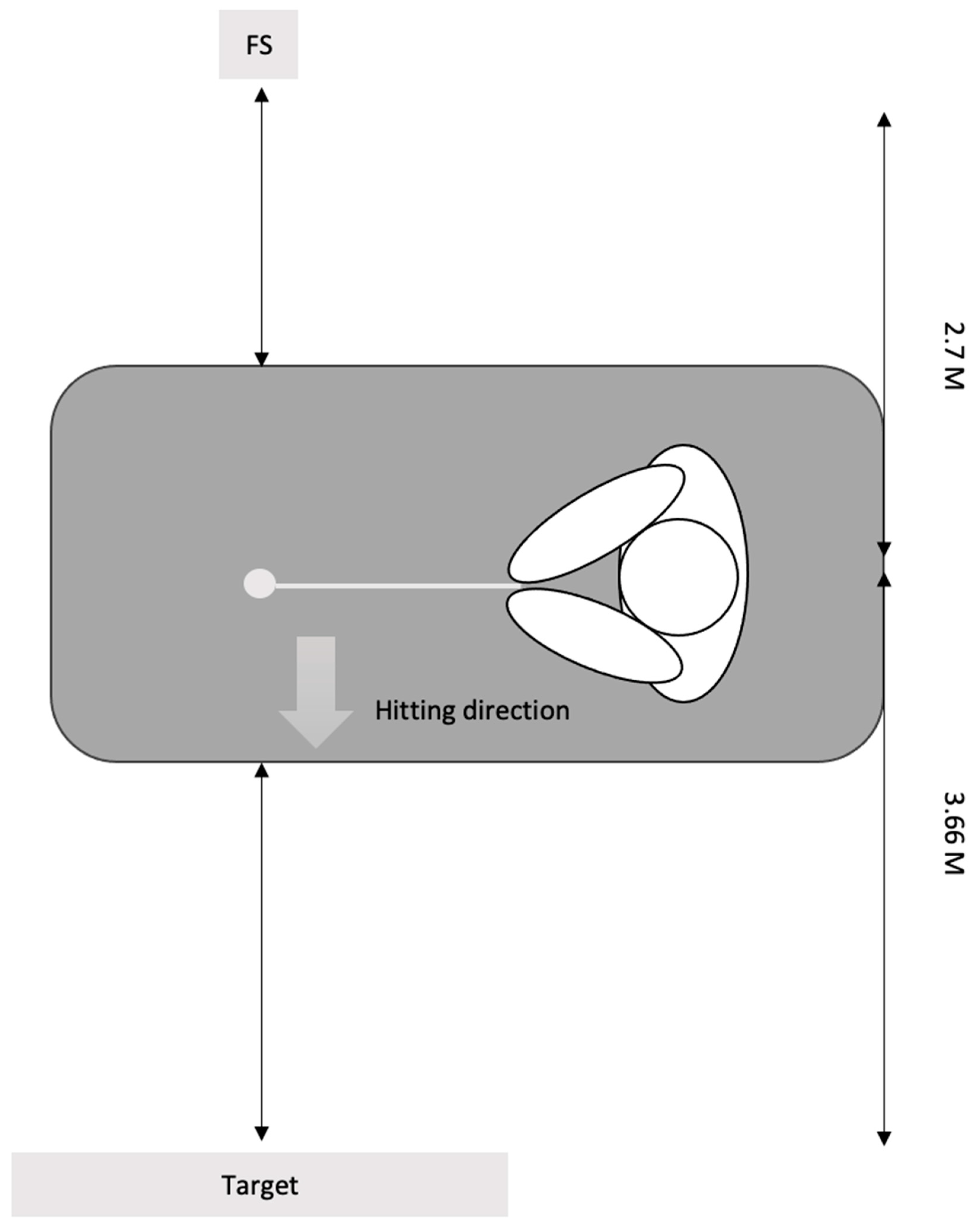

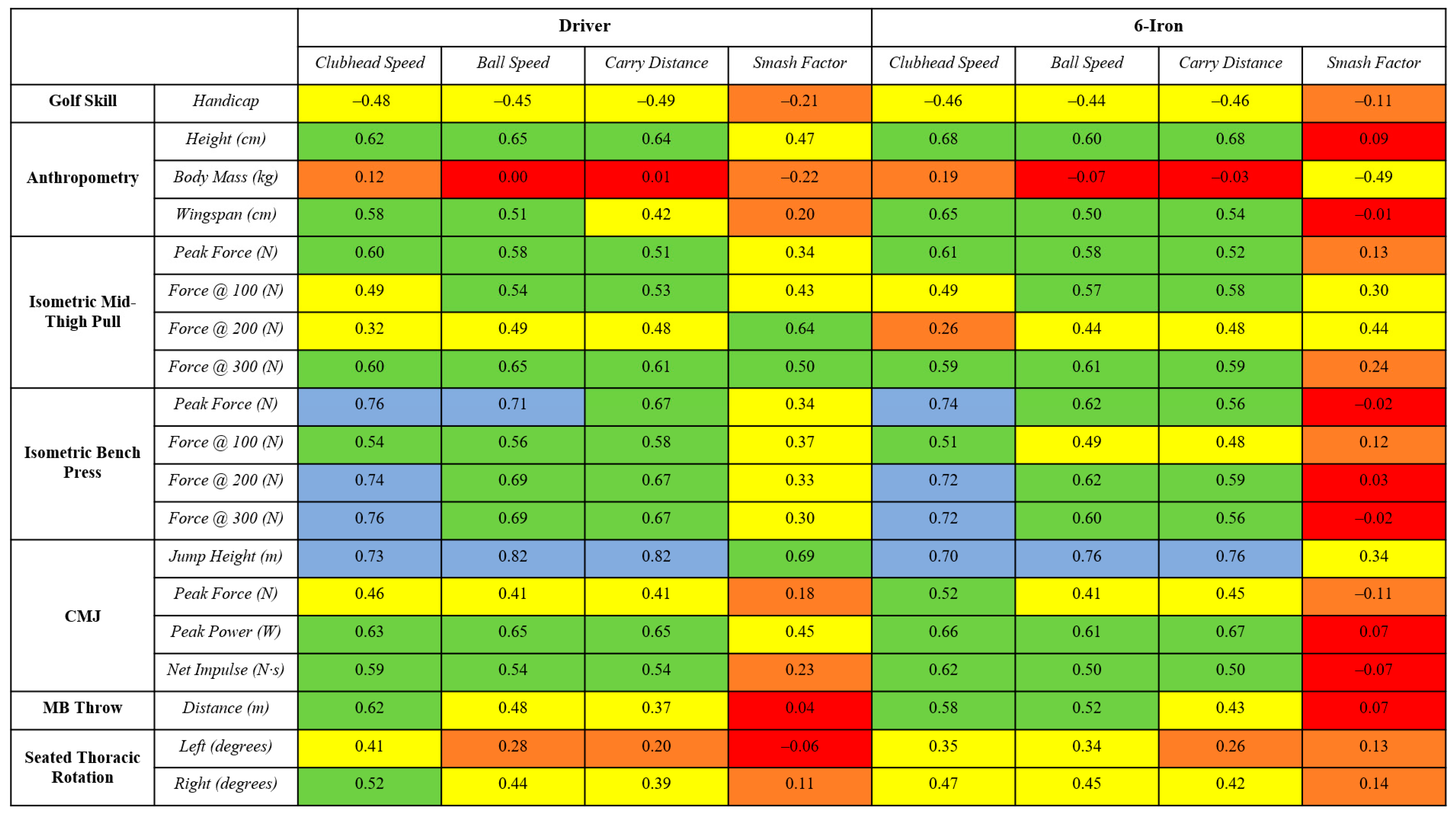
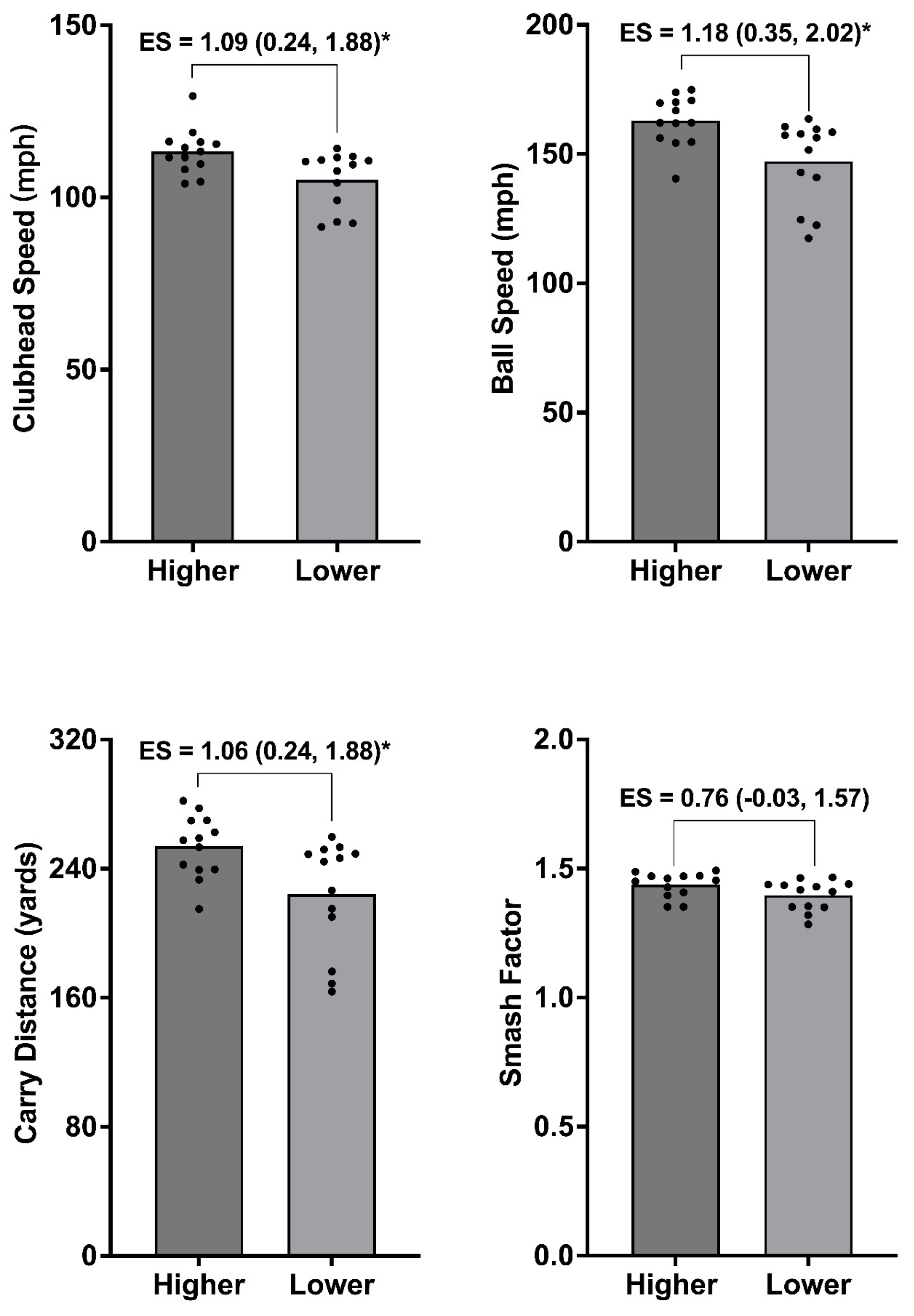
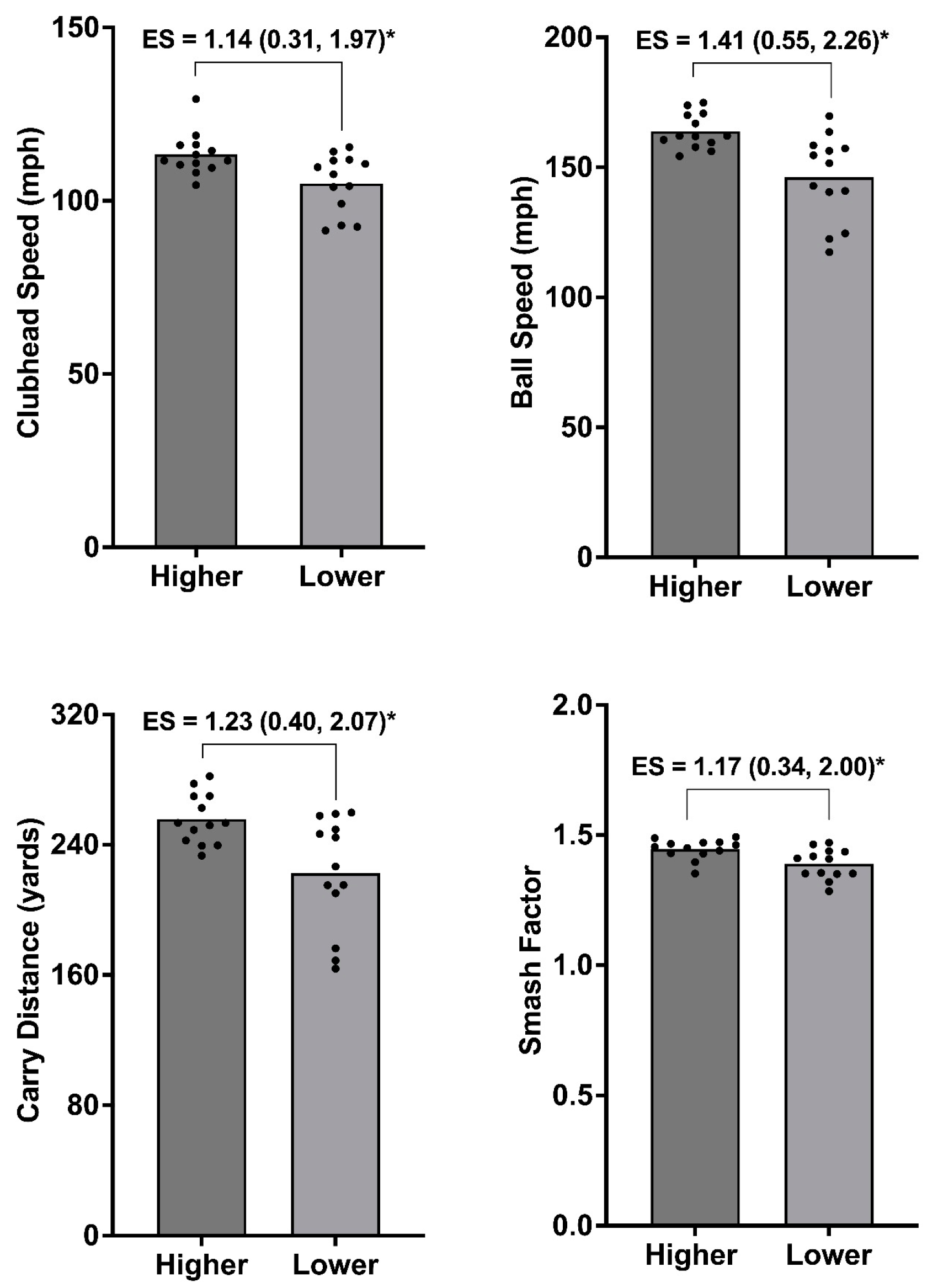
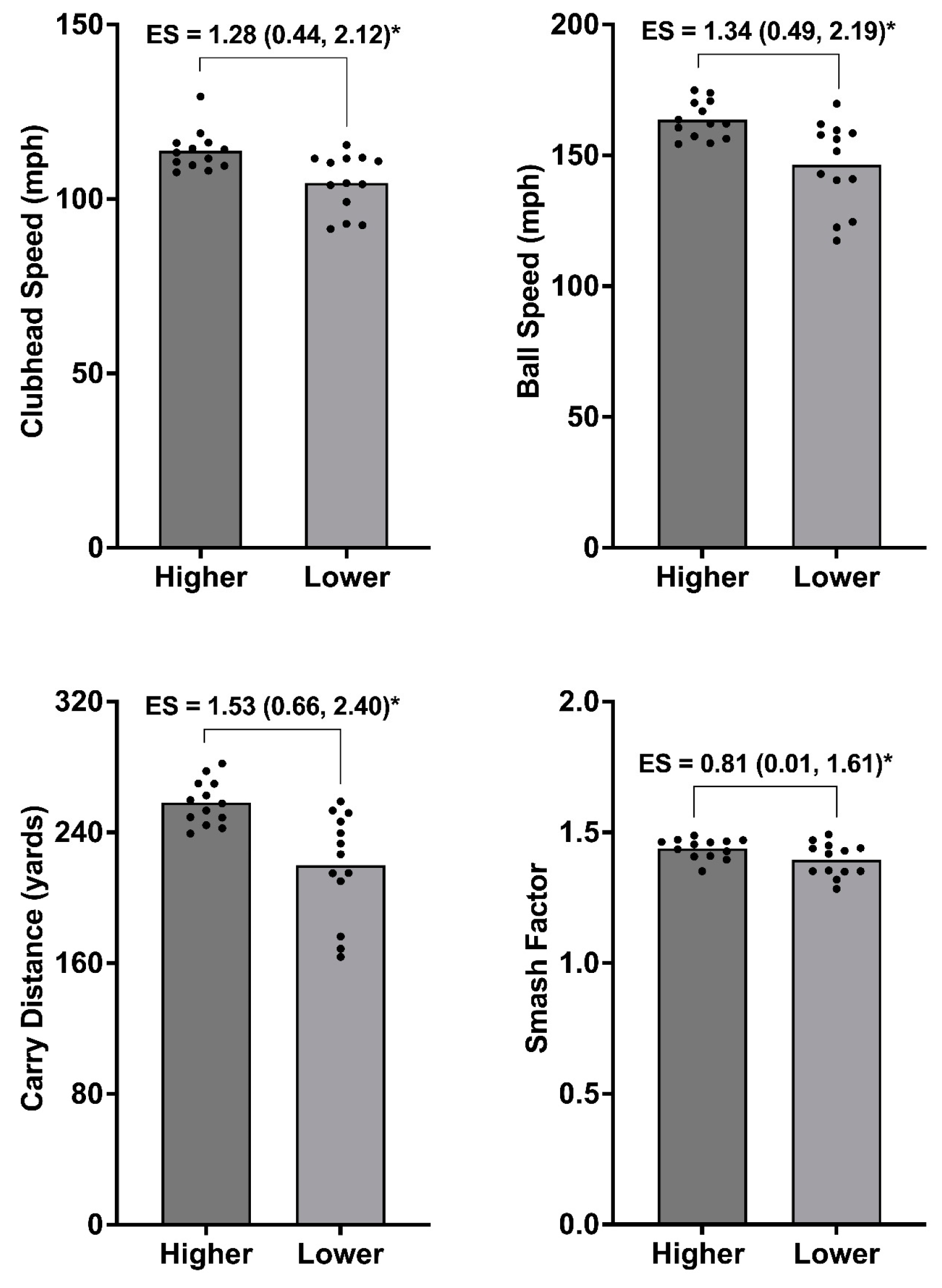
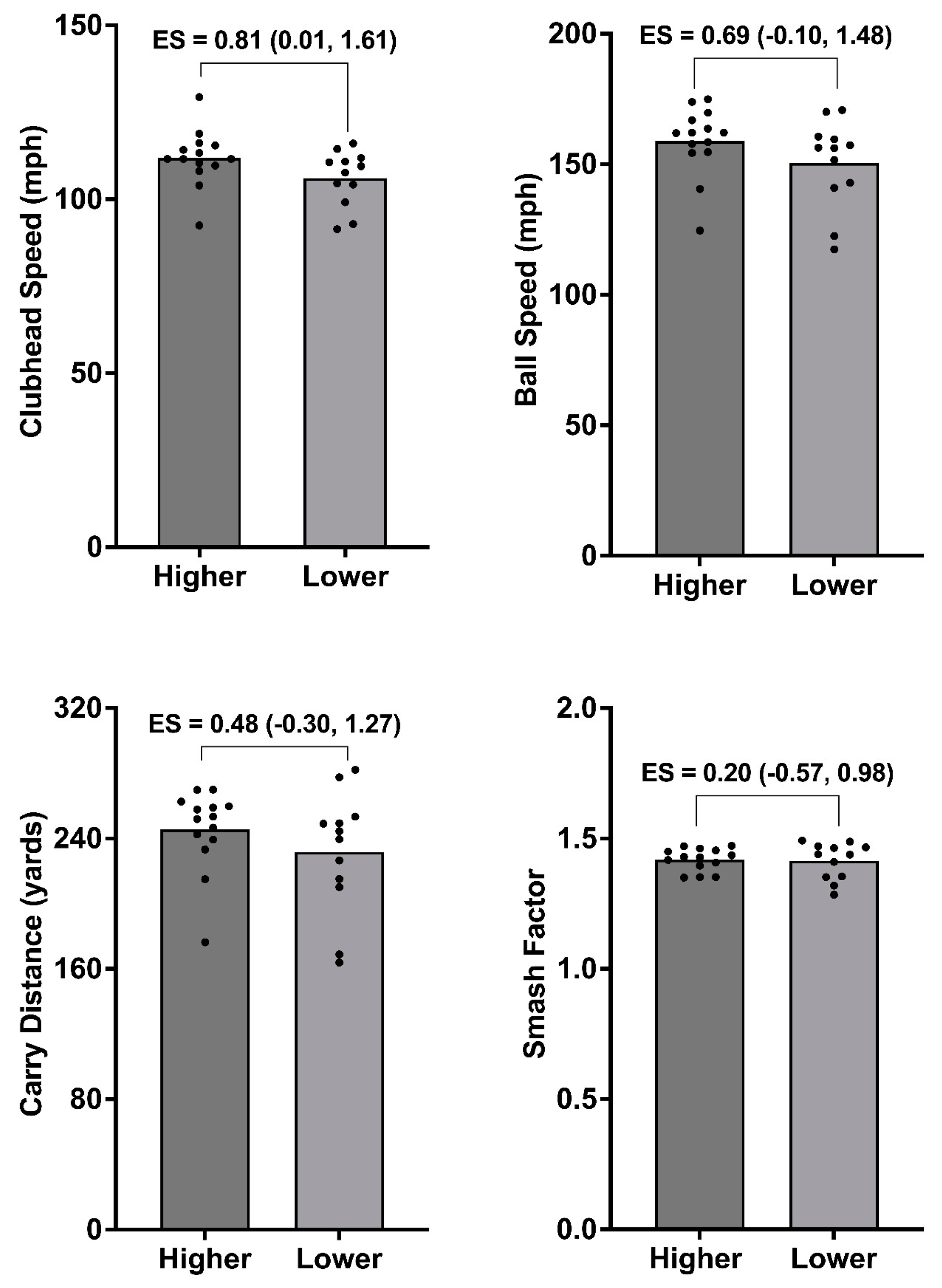
| Parameter | Unit of Measurement | Description of Parameter |
|---|---|---|
| Ball Speed | Miles per hour | The speed of the golf ball’s centre of gravity immediately after separation from the club face |
| Clubhead Speed | Miles per hour | The linear speed of the club head’s geometric centre just prior to first contact with the golf ball |
| Carry Distance | Yards | The straight-line distance between where the ball started and where the trajectory crosses a point that is the same height as where the ball was hit |
| Smash Factor | No units | The ratio between ball speed and the club speed |
| Variables | Driver | 6-Iron | ||||||
|---|---|---|---|---|---|---|---|---|
| Mean ± SD | ICC (95% CIs) | CV (95% CIs) | SEM | Mean ± SD | ICC (95% CIs) | CV (95% CIs) | SEM | |
| Clubhead Speed (mph) | 109.24 ± 8.43 | 0.99 (0.99, 1.00) | 0.64 (0.55, 0.77) | 0.84 | 92.92 ± 7.12 | 0.99 (0.98, 0.99) | 0.75 (0.65, 0.90) | 0.71 |
| Ball Speed (mph) | 155.06 ± 15.29 | 0.98 (0.96, 0.99) | 1.64 (1.42, 1.96) | 2.16 | 122.01 ± 10.80 | 0.90 (0.82, 0.95) | 3.00 (2.58, 3.59) | 3.42 |
| Carry Distance (yards) | 239.15 ± 31.33 | 0.94 (0.90, 0.97) | 3.54 (3.05, 4.24) | 7.67 | 169.81 ± 19.64 | 0.87 (0.77, 0.93) | 4.65 (4.00, 5.58) | 7.08 |
| Smash Factor | 1.42 ± 0.06 | 0.80 (0.61, 0.90) | 1.71 (2.06, 2.60) | 0.03 | 1.32 ± 0.06 | 0.65 (0.27, 0.83) | 2.84 (2.44, 3.40) | 0.04 |
| Physical Test Measure | Mean ± SD | ICC (95% CIs) | CV (95% CIs) | SEM |
|---|---|---|---|---|
| Anthropometry | ||||
| Height (cm) | 177.08 ± 7.18 | 1.00 (1.00, 1.00) | 0.20 (0.17, 0.24) | 0 |
| Mass (kg) | 77.40 ± 12.54 | 1.00 (0.99, 1.00) | 0.96 (0.83, 1.15) | 0 |
| Wingspan (cm) | 182.87 ± 8.92 | 1.00 (0.99, 1.00) | 0.30 (0.26, 0.35) | 0 |
| Isometric Mid-thigh Pull | ||||
| Peak Force (N) | 1357.62 ± 318.54 | 0.99 (0.98, 0.99) | 2.53 (2.18, 3.03) | 31.85 |
| Force at 100 ms (N) | 471.84 ± 185.02 | 0.85 (0.74, 0.92) | 19.76 (16.83, 24.03) | 71.66 |
| Force at 200 ms (N) | 762.25 ± 255.58 | 0.92 (0.86, 0.96) | 10.85 (9.30, 13.10) | 72.29 |
| Force at 300 ms (N) | 973.30 ± 235.00 | 0.94 (0.90, 0.97) | 6.02 (5.17, 7.23) | 57.56 |
| Countermovement Jump | ||||
| Jump Height (m) | 0.29 ± 0.07 | 0.99 (0.99, 1.00) | 2.33 (2.01, 2.79) | <0.01 |
| Peak Propulsive Power (W) | 3495.42 ± 827.97 | 0.99 (0.99, 1.00) | 1.98 (1.70, 2.37) | 82.80 |
| Peak Propulsive Force (N) | 1706.17 ± 314.36 | 0.97 (0.95, 0.98) | 3.28 (2.82, 3.93) | 54.45 |
| Net Impulse (N·s) | 180.58 ± 33.53 | 0.99 (0.99, 1.00) | 1.27 (1.09, 1.52) | 3.35 |
| Isometric Bench Press | ||||
| Peak Force (N) | 569.11 ± 200.25 | 0.98 (0.97, 0.99) | 5.30 (4.56, 6.36) | 28.32 |
| Force at 100 ms (N) | 328.84 ± 158.00 | 0.85 (0.74, 0.92) | 25.78 (21.89, 31.52) | 61.19 |
| Force at 200 ms (N) | 439.54 ± 156.24 | 0.97 (0.94, 0.98) | 7.69 (6.60, 9.26) | 27.06 |
| Force at 300 ms (N) | 481.26 ± 172.02 | 0.97 (0.94, 0.98) | 7.66 (6.58, 9.22) | 29.79 |
| Medicine Ball Throw | ||||
| Distance (m) | 3.6 ± 0.67 | 0.97 (0.96, 0.99) | 3.00 (2.58, 3.59) | 0.12 |
| Thoracic Spine Rotation | ||||
| Right Direction (°) | 69.44 ± 4.11 | 0.99 (0.98, 0.99) | 0.66 (0.57, 0.79) | 0.41 |
| Left Direction (°) | 66.01 ± 5.37 | 0.99 (0.99, 1.00) | 0.78 (0.67, 0.93) | 0.54 |
Disclaimer/Publisher’s Note: The statements, opinions and data contained in all publications are solely those of the individual author(s) and contributor(s) and not of MDPI and/or the editor(s). MDPI and/or the editor(s) disclaim responsibility for any injury to people or property resulting from any ideas, methods, instructions or products referred to in the content. |
© 2024 by the authors. Licensee MDPI, Basel, Switzerland. This article is an open access article distributed under the terms and conditions of the Creative Commons Attribution (CC BY) license (https://creativecommons.org/licenses/by/4.0/).
Share and Cite
Brennan, A.; Murray, A.; Coughlan, D.; Wells, J.; Xu, J.; Turner, A.; Brearley, S.; Bishop, C. Associations and Within-Group Differences in Physical Characteristics and Golf Performance Data in High-Level Amateur Players. Appl. Sci. 2024, 14, 1854. https://doi.org/10.3390/app14051854
Brennan A, Murray A, Coughlan D, Wells J, Xu J, Turner A, Brearley S, Bishop C. Associations and Within-Group Differences in Physical Characteristics and Golf Performance Data in High-Level Amateur Players. Applied Sciences. 2024; 14(5):1854. https://doi.org/10.3390/app14051854
Chicago/Turabian StyleBrennan, Alex, Andrew Murray, Dan Coughlan, Jack Wells, Jiaqing Xu, Anthony Turner, Simon Brearley, and Chris Bishop. 2024. "Associations and Within-Group Differences in Physical Characteristics and Golf Performance Data in High-Level Amateur Players" Applied Sciences 14, no. 5: 1854. https://doi.org/10.3390/app14051854
APA StyleBrennan, A., Murray, A., Coughlan, D., Wells, J., Xu, J., Turner, A., Brearley, S., & Bishop, C. (2024). Associations and Within-Group Differences in Physical Characteristics and Golf Performance Data in High-Level Amateur Players. Applied Sciences, 14(5), 1854. https://doi.org/10.3390/app14051854







